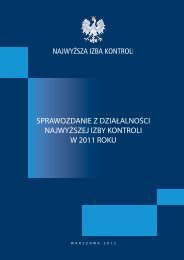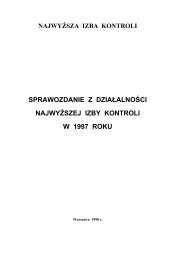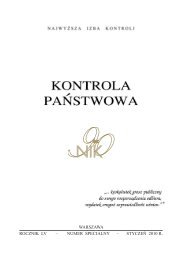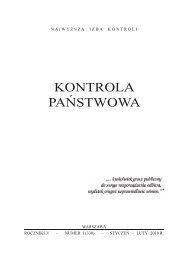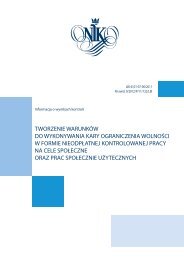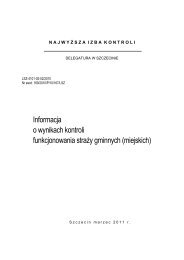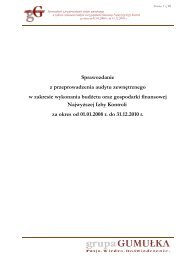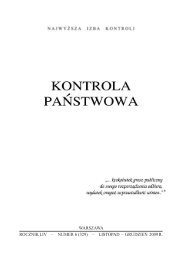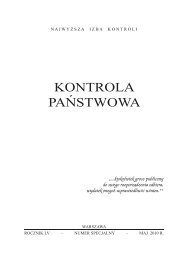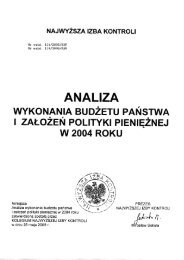NIK peer review report - Najwyższa Izba Kontroli
NIK peer review report - Najwyższa Izba Kontroli
NIK peer review report - Najwyższa Izba Kontroli
Create successful ePaper yourself
Turn your PDF publications into a flip-book with our unique Google optimized e-Paper software.
Examples of how to deal with the issue of effectivenessIn a <strong>report</strong> on the implementation of tasks in the scope of overweight andobesity prevention among children and adolescents (P/10/190) the audit wasfocused on determining whether the programme was implemented. The auditasked whether the tasks under the programme had been implemented in accordancewith the regulations. Directly addressing the question of effect orimpact would have entailed a discussion of whether or not the programmehad the planned impact. It could be argued that some of the tasks implementedunder the programme were not evidence-based, i.e. handbooks andconferences are not measures for reducing overweight and obesity.In a <strong>report</strong> on the implementation of flood protection in the Oder river basin,including the ”Programme for the Oder-2006” (P/10/180) the audit acceptedthe audited programme ‘as is’ because of the technical aspects of the matter.Effectiveness in this area would involve assessing whether the preventive actionsplanned would be able to prevent flooding. Often the SAI is not in possessionof the relevant skills to assess the effects of tasks performed, but caninstead assess, if the auditee has established performance indicators andevaluated possible impact. In this case <strong>NIK</strong> focused on assessing the way theprogramme was implemented.In an audit of the use of railway properties for commercial purposes not relatedto the rail traffic (P/10/063) the audit programme focused largely on complianceissues such as whether or not a strategy was followed etc. In the auditprogramme the objectives of the auditees’ activities – e.g. enabling the companyto repay its debt and thus improve the standard of passenger services –are mentioned, but could have been integrated into the design and implementationof the audit.In an audit of the execution of the government programme “My sports field” –Orlik 2012 by local government administrative units (P/10/146) the end-userperspective could have been included. The question of the benefit of the programmefor those using the facilities could have increased the performanceelement of the audit.A number of factors may have contributed to the less pronounced focus onperformance auditing:As <strong>NIK</strong>’s audits include elements from different audit types, performanceauditing is in competition with financial, regularity and complianceauditing.The 3 EsEconomy – keeping thecost lowEfficiency – making themost of available resourcesEffectiveness – achievingthe stipulated aims and objectives.See ISSAI 100 FundamentalPrinciples of Public SectorAuditing (Exposuredraft) and ISSAI 3000Standards and guidelinesfor performance auditing.Regularity Audit is an essentialaspect of governmentauditing. The mainobjective for the SAI is tomake sure that the statebudget and accounts arecomplete and valid. Thisprovides parliament etc.with assurance about thesize and development ofthe financial obligations ofthe state. The SAI examinesthe accounts and financialstatements of theadministration to assurethat operations have beencorrectly undertaken, completed,passed, paid andregistered.See ISSAI 300 FieldStandards in GovernmentAuditingAudits focusing on economy, efficiency or effectiveness require differentaudit methodologies, and often a more technical and specialistbasedassessment of the results achieved by the auditee. Financial,regularity and compliance auditing can deliver almost statistically andlegally valid evidence of the level of compliance, i.e. the extent towhich activities are performed in compliance with existing law and objectives.Thus, performance auditing requires more subject-related assessments,and often more experimental audit designs. Finally, auditresults are based on a type of audit evidence that is often more opento discussion.Regularity audit is oftengrouped with both financialand compliance audit andcan be considered a type offinancial audit with a morestrict focus on legal aspects(compliance with applicablebudgetary laws and regulations).PEER REVIEW REPORT 19




